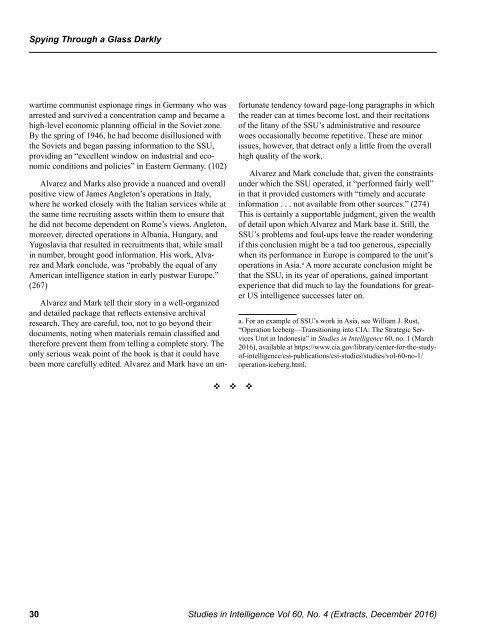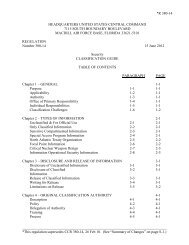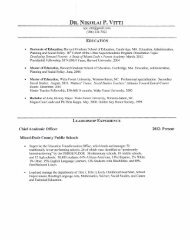extracts-studies-dec-2016
extracts-studies-dec-2016
extracts-studies-dec-2016
Create successful ePaper yourself
Turn your PDF publications into a flip-book with our unique Google optimized e-Paper software.
<br />
Spying Through a Glass Darkly<br />
wartime communist espionage rings in Germany who was<br />
arrested and survived a concentration camp and became a<br />
high-level economic planning official in the Soviet zone.<br />
By the spring of 1946, he had become disillusioned with<br />
the Soviets and began passing information to the SSU,<br />
providing an “excellent window on industrial and economic<br />
conditions and policies” in Eastern Germany. (102)<br />
Alvarez and Marks also provide a nuanced and overall<br />
positive view of James Angleton’s operations in Italy,<br />
where he worked closely with the Italian services while at<br />
the same time recruiting assets within them to ensure that<br />
he did not become dependent on Rome’s views. Angleton,<br />
moreover, directed operations in Albania, Hungary, and<br />
Yugoslavia that resulted in recruitments that, while small<br />
in number, brought good information. His work, Alvarez<br />
and Mark conclude, was “probably the equal of any<br />
American intelligence station in early postwar Europe.”<br />
(267)<br />
Alvarez and Mark tell their story in a well-organized<br />
and detailed package that reflects extensive archival<br />
research. They are careful, too, not to go beyond their<br />
documents, noting when materials remain classified and<br />
therefore prevent them from telling a complete story. The<br />
only serious weak point of the book is that it could have<br />
been more carefully edited. Alvarez and Mark have an unfortunate<br />
tendency toward page-long paragraphs in which<br />
the reader can at times become lost, and their recitations<br />
of the litany of the SSU’s administrative and resource<br />
woes occasionally become repetitive. These are minor<br />
issues, however, that detract only a little from the overall<br />
high quality of the work.<br />
Alvarez and Mark conclude that, given the constraints<br />
under which the SSU operated, it “performed fairly well”<br />
in that it provided customers with “timely and accurate<br />
information . . . not available from other sources.” (274)<br />
This is certainly a supportable judgment, given the wealth<br />
of detail upon which Alvarez and Mark base it. Still, the<br />
SSU’s problems and foul-ups leave the reader wondering<br />
if this conclusion might be a tad too generous, especially<br />
when its performance in Europe is compared to the unit’s<br />
operations in Asia. a A more accurate conclusion might be<br />
that the SSU, in its year of operations, gained important<br />
experience that did much to lay the foundations for greater<br />
US intelligence successes later on.<br />
a. For an example of SSU’s work in Asia, see William J. Rust,<br />
“Operation Iceberg—Transitioning into CIA: The Strategic Services<br />
Unit in Indonesia” in Studies in Intelligence 60, no. 1 (March<br />
<strong>2016</strong>), available at https://www.cia.gov/library/center-for-the-studyof-intelligence/csi-publications/csi-<strong>studies</strong>/<strong>studies</strong>/vol-60-no-1/<br />
operation-iceberg.html.<br />
v v v<br />
30 Studies in Intelligence Vol 60, No. 4 (Extracts, December <strong>2016</strong>)




